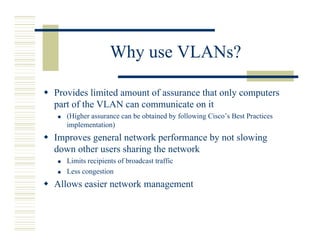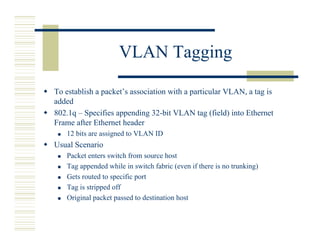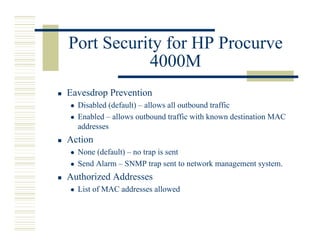Vlan
- 1. VLANs and Port Security Gary Lee Nelson Lee Kelly Lum CS 996 10/23/2003
- 2. Switched Networked Classical logical network topology Switches and hubs connect to end-nodes Routers connect switched, providing backbone Separates multicast and collision domain into two segments But routers add latency! Noticeable as networks become larger
- 3. Adding Latency Switches are Layer 2 network devices Forward information based on layer 2, MAC addresses Routers are Layer 3 network devices Forward information based on layer 3, IP addresses Switches can better allocate bandwidth Unlike hubs, they do not broadcast traffic to all ports, but keeps track of which computer is connected to which port
- 5. Classical Corporate Network Limitations End-nodes are connected to switches Large number of switches connected to routers Routers need to route large amount of packets End-nodes need to be physically connected to switches End-nodes need to be 100m or closer to switch Cannot further segment switches to limit broadcast or collision domains If you have research lab and public relations on same switch You cannot spread a department’s computers over a wide area, such as a scientific research computer laboratory across campus!!
- 6. Ideal Switched Network • Switches are interconnected by a circuit-switched ATM backbone •But now there is one huge collision domain!!
- 7. What is a Virtual LAN? A physically switched network that is logically segmented A new set of broadcast domain are created within the switches Allows machines on physically different LAN segments to behave as if they were part of the same segment
- 8. Sample LAN There is a three-story building that is furnished with three computers per floor The three departments are oddly partitioned such that one computer from each floor constitutes 1/3 of the department We now have to move computers from each floor to its proper location so we can use hubs A very tedious and ridiculous job for network admin! (Let an intern do it…)
- 9. Sample LAN into a VLAN By using switches, we can assign computer on different floors to VLAN1, VLAN2, and VLAN3 Now, logically, a department is spread across 3 floors even though they are physically located on different floors
- 11. Why use VLANs? Provides limited amount of assurance that only computers part of the VLAN can communicate on it (Higher assurance can be obtained by following Cisco’s Best Practices implementation) Improves general network performance by not slowing down other users sharing the network Limits recipients of broadcast traffic Less congestion Allows easier network management
- 12. VLAN Tagging To establish a packet’s association with a particular VLAN, a tag is added 802.1q – Specifies appending 32-bit VLAN tag (field) into Ethernet Frame after Ethernet header 12 bits are assigned to VLAN ID Usual Scenario Packet enters switch from source host Tag appended while in switch fabric (even if there is no trunking) Gets routed to specific port Tag is stripped off Original packet passed to destination host
- 13. How do packets move in a VLAN? Three basic models for controlling how a packet get routed inside a VLAN switch Port based Network administrator assigns a port on a switch to a VLAN ID Need to manually enter it into the switch, so if a computer moves, then you have to manually update the changes If a repeater is attached to a port, all of the users on the repeater must be on the same VLAN MAC Address based Switch maintains a table of addresses and their corresponding VLAN memberships Easy to keep track of computers that moved Can be, but not easily, part of multiple VLANs
- 14. How do packets move in a VLAN? Layer 3 based Membership is based on protocols and Layer 3 addresses Ex.: an IP subnet can be a VLAN or an IPX network Can use non-routable protocols like NetBIOS instead of IP or IPX
- 15. How is VLAN membership indicated? Tagging packets internally and between trunks Tag is appended when packet arrives at switch Tag is stripped when packet reaches destination on same switch On a trunk: implicit and explicit Implicit - membership indicated by MAC address All switches supporting a VLAN must share a table of addresses Explicit – tag added to the packet to indicate VLAN membership Used by Cisco ISL and 802.1Q
- 16. VTP – VLAN Trunking Protocol ISL – Pre-802.1q : Cisco proprietary Inter-switch Link protocol VTP – Management protocol that spans the trunks lines (ISL, 802.1q port, LANE, etc) Creates a new domain of switches for VLAN management Make one change, let VTP worry about propagating settings across inter-connected switches
- 17. Port Security Enables blocking of unauthorized MAC addresses access to ports Switches can then monitor the security of those ports Alerts may be sent to a network manager where appropriate action should be taken
- 18. Port Security for Cisco Catalyst Blocks input into a port if the MAC address is different from the set of MAC addresses assigned to the port Allows a maximum of 1024 MAC addresses plus one default MAC address for each port Manual or Automatic configuration Configuration stored in non-volatile RAM
- 19. Port Security for Cisco Catalyst (continued) Able to set an age time during which the port is secure. After the time has expired, the port becomes insecure. (WHY?) Default setting: Ports are secured permanently An attempting MAC address that is different from the secure MAC addresses on the port constitutes as a security violation After a security violation, ports are defaulted to shutdown permanently Port security not supported for trunk ports
- 20. Port Security for Cisco Catalyst (continued) MAC address Actions taken by the port: • Shut down permanently • Shut down for a period matches the MAC address with list of secure MAC Match allows the packet of time through addresses for the port (If shut down, an link- down trap is sent to NO match SNMP) • Enabled, but drops The port takes action. packets from insecure hosts
- 21. Port Security for HP Procurve 4000M For any port, one or both of the following can be configured Authorized Addresses – specify up to 8 MAC addresses allowed for inbound traffic Closes the port to any unauthorized device Prevent Eavesdropping – blocks outbound traffic to unknown destination addresses When a security violation is detected An alert flag is set for that port Sends an SNMP trap to network management system
- 22. Port Security for HP Procurve 4000M Port Security is defaulted to off. Configuration parameters Port – port to enable port security Learn mode Continuous (default) – port learns about MAC addresses from inbound traffic, and addresses are Aged out. Static – Manually enter up to 8 MAC addresses Address Limit – the number of addresses to allow 1 is default, 8 is the maximum
- 23. Port Security for HP Procurve 4000M Eavesdrop Prevention Disabled (default) – allows all outbound traffic Enabled – allows outbound traffic with known destination MAC addresses Action None (default) – no trap is sent Send Alarm – SNMP trap sent to network management system. Authorized Addresses List of MAC addresses allowed
- 24. Resources Cisco Catalyst 2980G-A Product Overview - http://cisco.com/univercd/cc/td/doc/pcat/ca2980g.htm Cisco Catalyst 2900 Series Configuration Guide - http://www.cisco.com/en/US/products/hw/switches/ps606/prod ucts_configuration_guide_book09186a008007f199.html Hewlett-Packard's support site - HP Procurve 4000M - http://www.hp.com/rnd/support/index.htm Types of VLAN - http://www.vlan- analyser.co.uk/content/semitechnical.htm
























